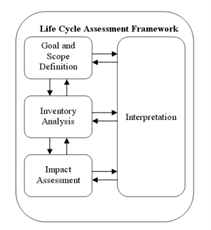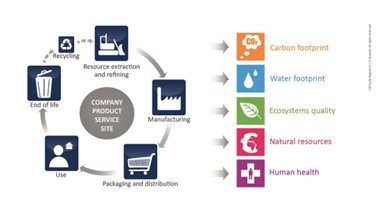In This Section
What is LCA?
According to the EPA Life Cycle Analysis is a technique to assess the environmental aspects and potential impacts associated with a product, process, or service, by (1) Compiling an inventory of relevant energy and material inputs and environmental releases (2) Evaluating the potential environmental impacts associated with identified inputs and releases. Interpreting the results to help you make a more informed decision.
According to the International Organization for Standardization (ISO) defines life cycle assessment (LCA) as the following:
“Compilation and evaluation of the inputs, outputs and the potential environmental impacts of a product system throughout its life cycle” (ISO 14040: 1997)[1].
Why should I use LCA?

Using an LCA will help companies identify environmental hot spots in products, packages and materials and can establish the benchmark against which improvements can be measured. Companies use LCA to demonstrate transparency and corporate credibility to stakeholders and customers (especially if making environmental claims). LCA is also used in new product and package development, when environmental footprint is important to the future marketing or cost structure of a product or package.
Overview of LCA tools
 LCA can be performed at different levels depending on the type of questions being asked, the purpose of the study, or the state of development of a new product or a new packaging. The work to perform a LCA can range from a couple of hours to more than 100 days of work. Practitioners generally classify LCAs in two different categories in terms of level of detail:
LCA can be performed at different levels depending on the type of questions being asked, the purpose of the study, or the state of development of a new product or a new packaging. The work to perform a LCA can range from a couple of hours to more than 100 days of work. Practitioners generally classify LCAs in two different categories in terms of level of detail:
| Type of LCA tool | Strengths | Weaknesses | Application |
| Eco Design or Screening Tools | Quick, low cost, consistent, can be used by non-experts | Low flexibility. No capacity to capture specificities Limited possibility to support environmental claims | Quick environmental evaluation of a product, process, or package. Suited for non-expert in a well defined study. Typically an in-house tool used on licence from developer. |
| Comprehensive | Robustness, flexibility Can support marketing claims after external peer review. | Significantly more costly, takes longer, requires expert knowledge | Evaluation of a product and comparison with alternatives to support marketing claims about the environmental impact of a product. Typically out-sourced. |
Although not intended to be an exhaustive list of LCA solution providers, the following summarizes the leading LCA options, including key features and capabilities of relevance to the food and produce sector. These are summarized by Eco-Design or Screening Tools, and Comprehensive LCA and Tools.
Eco-design or screening tools directory
| LCA Tool | Key Features | Applications | Access |
| Trayak EcoImpact – COMPASS for packaging | A complete cloud hosted, secure, enterprise level suite of product and packaging sustainability software to manage corporate sustainability goals. COMPASS was originally conceived at the SPC (Sustainable Packaging Coalition) as a pioneering tool designed for packaging engineers. | Packaging, Products | Range of licences available. |
| A world leading LCA software used by industry, research institutes, and consultants in more than 80 countries. Built on robust science and life cycle thinking, the sustainability software is ideal for product designers, decision-makers and sustainability experts. | Packaging, Products | Download- Variety of licences available | |
Sphera | Combines world leading Life Cycle Assessment (LCA) modelling and reporting software, content databases with intuitive data collection and reporting tools. Enables LCA professionals to affect business results by helping to save money, reduce risk, communicate product benefits and increase revenue. | Consumer Goods & Packaging | Can download free trial. One licence per computer |
| Helps companies embed ecodesign into the heart of the packaging development process and deploy data-driven packaging choices at scale. This intuitive tool makes robust environmental data accessible to packaging designers, supporting them in making smarter, more resilient design decisions and empowering them to develop sustainable packaging solutions. | Packaging, Food & Beverage | Consulting services | |
| Empauer / Selerant EcoDex | Ecodex is an eco-design LCA software tool for evaluating and understanding the environmental impacts of food products and packaging. Designed to be used by non-experts, it helps companies improve the sustainability of new products or the existing portfolio, in a cost-effective and simple way. | Packaging, Food & Beverage | Access through subscription or consulting services |
Comprehensive LCA Consulting and Tools
| Consultancy | Overview | Areas of expertise | Clients / Collaborations examples |
| CIRAIG | CIRAIG (International Reference Centre for Life Cycle Assessment and Sustainable Transition)is a research group and center of expertise on sustainability and life cycle thinking. Through leading-edge research, expert services on sustainability, and education, the CIRAIG aims to shape and implement metrics focused on life cycle thinking. | Life cycle assessment and other analyses Sustainability strategy Development of custom tools | Nestle, Solvay, McGill, University of Waterloo, CPP |
| Groupe Ageco | Provides customized support that takes into account the economic, environmental, social, and governance aspects of a business. A Quebec pioneer in agri-food analysis and strategy and a leader in corporate responsibility, help identify and understand issues, analyze stakeholders’ expectations, and evaluate practices. | Agri-food analysis and strategies | CIRAIG |
| Quantis | Sustainable transformation can’t be achieved by maintaining the status quo, but by implementing initiatives that deliver meaningful progress. Quantis brings expertise and tools to help clients engage with internal and external stakeholders and key players across the value chain to put sustainability into practice and ensure the right incentives and levers of change are in place. | Multi business sectors | Danone, Tim Hortons, Kellogg’s, Sealed Air, Winpak, TetraPak |
| Pre Sustainability | Support organizations to measure, improve and communicate their sustainability performance. We also help them develop effective strategies and integrate sustainability in the supply chain, product development or organization. Our software solutions are supported by a team of professional consultants, who can also provide guidance through standard or tailored training sessions. | Multi business sectors | P&G, European Commission |
| Franklin Associates | Provides life cycle services that track and identify the true costs and environmental impacts of products or processes, revealing areas where improvements and cost reductions are needed to maximize company profits and minimize environmental burdens. | Multi business sectors LCA and solid waste management. | US Federal Agencies, Institutions, Corporations |
In order to consider the various LCA screening tools and related consulting services, the following outlines the phases of a life cycle assessment for food and produce packaging.
Life Cycle Assessment Phases
There are traditionally five main phases of a life cycle assessment of packaging.
1. Goals and Scoping
There needs to be a clear reason for performing the LCA and a clear definition of the way the results of the LCA will be communicated internally and externally. The goals and scoping phase determines:
- Which processes will be included
- Which environmental concerns will be included
- What economic or social good is provided by the packaging in question
- Technical issues that may arise and how they will be dealt with
- The audience for the LCA
The goals and scoping phase is important because it ensures consistency throughout the assessment. During the scoping phase, it is vital to document what route the packaging (with product) will take during its lifetime, from raw materials to recovery.
2. Life Cycle Inventory
The life cycle inventory phase, or LCI, is the information-gathering phase for all environmental inputs and outputs for all parts of the product system that is being examined. The life cycle inventory phase includes:
- Materials
- Energy
- Chemicals
- Air emissions
- Water emissions
- Solid waste
The LCI also involves modeling of the product system, data collection, and verification of data for inputs and output of all parts of the product system.
3. Life Cycle Impact Assessment
During the Life Cycle Impact Assessment, inventory data is converted to indicators for each impact category. Categories of the Life Cycle Impact Assessment may include:
- Global warming
- Depletion of ozone
- Pollution
- Acidification
- Eutrophication
- Natural resource usage and impact (habitat, water, fossil fuels, minerals, biological resources)
- Human toxicity
- Ecotoxicity
During this phase, the parameters to look at are determined so you can make comparisons between packaging.
4. Interpretation
The interpretation phase involves the analysis of impact data. This phase involves a critical review, a determination of how the data will be shared, and a presentation of the results to relevant stakeholders.
5. Improvement
This is where you put the results from your interpretation into action to make packaging improvements.
Supporting Resources
- Life Cycle Assessment: An Executive Overview of Applications, Market Drivers and Business Benefits (2011) https://gabi.sphera.com/uploads/media/Executive_Study_Life_Cycle_Assessment_04.pdf
- Guidelines for Life Cycle Assessment: Industry in Quebec (2011) https://www.eeq.ca//wp-content/uploads/lignesdirectrices_emballages_engl.pdf
- How to perform a Life Cycle Assessment of Packaging https://www.billerudkorsnas.com/managed-packaging/knowledge-center/articles/how-to-perform-a-life-cycle-assessment-of-packaging
- LCA what it tells us what it doesn’t https://www.ecoenclose.com/blog/packaging-life-cycle-analysis-what-it-tells-us-what-it-doesnt-/